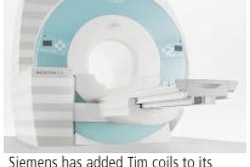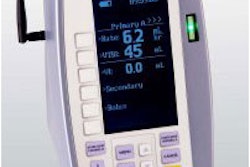CHICAGO - Score two points for breast MR spectroscopy (MRS): The modality was sensitive enough to catch all types of invasive cancer and was not prone to false-positive findings in normal breast parenchyma, according to presentations Sunday at the 2005 RSNA meeting.
"Spectroscopy gives us chemical information about tissue. The choline concentration in different types of breast cancers has been variable," said Dr. Lia Bartella from Memorial Sloan-Kettering Cancer Center in New York City.
Bartella presented two studies. The first looked at whether the sensitivity of MRS varied according to cancer histology. The second evaluated the choline signal from breast MRS in normal tissue, particularly during the menstrual cycle.
In the first study, breast MRS was performed in 79 women with malignant lesions (equal to or greater than 1 cm) that were either suspected based on 1.5-tesla MRI or biopsy-proven. Of these 79, 43 had invasive cancer and the majority of these (72%) were invasive ductal carcinoma.
Single-voxel MRS data was collected from an area encompassing the lesion using a PRESS sequence. The median voxel size was 3.75 cc. MRS findings were considered positive if the signal-to-noise ratio (SNR) of the choline resonance peak was greater than or equal to 2 and the results were correlated with histology. The total scan time was 10 minutes.
According to the results, the median lesion size of the cancers was 2.4 cm. All invasive cancers -- ductal, lobular, and a mix of the two -- demonstrated a positive choline peak. The sensitivity of MRS for pinpointing invasive cancer was 98%.
There was one false-negative study, Bartella said. This was a 1.4 cm invasive ductal cancer. While no choline peak was demonstrated on the MRS exam, this was most likely due to patient movement during the study, she explained.
"Single-voxel MR spectroscopy at 1.5-tesla showed choline peaks in invasive breast cancers regardless of the histology, in lesions 1.3 cm or larger, with a total scanning time of 10 minutes," Bartella said. "Further study is needed to evaluate smaller lesions and in-situ carcinomas."
For the second paper, Bartella began by explaining that a pitfall of breast MRI is that normal parenchyma may enhance especially during the menstrual cycle. This can lead to false-positive results.
"It is well-known and well-documented that MRI is influenced by enhancement from cyclical changes of normal breast parenchyma," she said. "In spectroscopy, the concentration of choline-containing compounds is higher in malignancy, but choline has been detected in normal breast tissue at 4-tesla. The purpose of our study was to determine if choline is detectable in normal breast tissue on 1.5-tesla and to see whether this is affected by cyclical changes."
The study examined the presence or absence of a choline signal from breast MRS in normal tissue. MRS was performed on 27 women who were enrolled in a breast MRI screening trial. Of the 27, 69% were postmenopausal and 31% were premenopausal. Of the latter group, two were scanned during week one of their cycle, four during week two, one during week three, and one during week four.
The women underwent 1.5-tesla MR imaging and MRS using a phased-array breast coil. Single-voxel MRS data were collected from a box encompassing enhancing glandular tissue. MRS findings were correlated with histology and MRI BI-RAD.
"Voxel placement was placed after reviewing T1-weighted, nonfat saturated, precontrast images because then we could identify the glandular part of the breast, not the fatty part of the breast. Also, the postcontrast images were reviewed just to make sure that at the site that the voxel was placed, no obvious enhancing mass was seen. Again, the scanning time was 10 minutes."
According to these results, none of these women demonstrated a positive choline peak and there were no false-positive choline peaks. The majority of cases (78%) were classified as BI-RAD 1. In four cases (15%), the lesions were categorized as BI-RAD 3. One BI-RADS 4 lesion was deemed benign on biopsy. Biopsy of the other BI-RADS 4 lesions yielded an invasive ductal carcinoma (6 mm lesion) and subsequent mastectomy did not reveal any other malignant sites.
"The specificity of spectroscopy on 1.5-tesla may be unaffected by cyclical changes. Therefore, spectroscopy may increase the specificity of MRI for premenopausal patients," Bartella said.
RSNA session moderator Dr. Christiane Kuhl commented that any additional studies that the group did in this area should include women who do experience hormonal changes and subsequent contrast enhancement shifts on MR.
A session attendee questioned whether Bartella's group had overstated their conclusion because they included only two patients in weeks three and four of the menstrual cycle, and they did not make any serial observations. Bartella acknowledged that this was a small patient cohort. A larger population would be needed for a study that included serial patient follow-up, she said.
By Shalmali Pal
AuntMinnie.com staff writer
November 27, 2005
Related Reading
MRI continues to make headway in breast cancer imaging, October 28, 2005
MR spectroscopy aids breast MR imaging, July 29, 2005
Gadobenate dimeglumine MR spots abnormal breast vascularity, cancer, June 8, 2005
Copyright © 2005 AuntMinnie.com



















